 Image search results - "atsuta" Image search results - "atsuta" |

I always visit a different shrine on New Year's Day, so for 2009, I visited Atsuta Jingu Shrine in Nagoya. JR Atsuta Station on the Tokaido Line is one train station near Atsuta Jingu Shrine. JR熱田駅
|
|

Shopping arcade on the way to the shrine from Atsuta Station.Atsuta Jingu is near Meitetsu Jingumae Station, JR Atsuta Station on the Tokaido Line, Atsuta Jingu Nishi Station (renamed from Jingu Nishi Station on Jan. 4, 2023) on the Meijo subway line, and Atsuta Jingu Tenma-cho Station (renamed from Tenma-choStation on Jan. 4, 2023) on the Meijo subway line.
|
|

Another train station near Atsuta Shrine is Meitetsu Jingumae Station (this is closer than Atsuta Station). 名鉄神宮前駅
|
|

The road in front of Meitetsu Jingumae Station was closed to traffic, allowing pedestrians to get to Atsuta Shrine on New Year's Day.
|
|

Atsuta Jingu is one of Japan's most important shrines as it enshrines one of the three Imperial Regalia of Japan, the sacred (and perhaps legendary) sword called Kusanagi-no-Tsurugi ("Grass Cutting Sword"). 草薙の剣
|
|

Many food stalls line the way to the shrine on New Year's Day.
|
|

One normal gate was closed and we all had to enter through the East Gate.
|
|

The East torii gate of Atsuta Jingu Shrine, made of wood. Atsuta Jingu worships Atsuta-no-Ookami or Amaterasu-Omikami, the Sun Goddess represented by Kusanagi-no-tsurugi, the sacred sword.
|
|

This is where the crowd begins on New Year's Day. The shrine also worships four other deities: Susanoo-no-mikoto, Yamato-Takeru-no-Mikoto, and Takeinadane-no-Mikoto and Miyasuhime-no-Mikoto, the parents of the Owari natives (Nagoya area).
|
|

Banner read "Happy New Year."
|
|

Atsuta Shrine was established about 1900 years ago. In the centuries past, the shrine has been patronized by major historical figures such as Oda Nobunaga, Toyotomi Hideyoshi, and the Tokugawa shoguns (Ieyasu was originally from this area).
|
|

We soon hit a bottleneck where we had to wait a while as we slowly got nearer to the shrine.
|
|

We got to the wash fountain to purify ourselves.
|
|

From the ladle, pour the water into your hand and sip the water to purify yourself before visiting the shrine. This was a most crowded place.
|
|

Wash fountain
|
|

The crowd thickens and it was stop and go, repeatedly.
|
|

Barrels of sake.
|
|

We stand still.
|
|

We want to go straight.
|
|

Finally, the shrine is in sight.
|
|

Approaching the final torii.
|
|

The police were holding back the crowd at regular intervals before they could enter the shrine's worship area.
|
|

Now we stand in line to pray before the shrine.
|
|

Standing in line to pray.
|
|
|
|

Getting closer.
|
|
|

This is what we wanted to see. The offertory pit where people throw their money in front of the Hongu main shrine. 本宮
|
|

New Year's prayers at Atsuta Jingu Shrine on Jan. 1.
|
|
|

Coins, bills, gift certificates, and even wallets were thrown in here.
|
|
|
|
|

The shrine's bank will love to count all this money. It must be their favorite time of year.
|
|

I wonder how much money these wallets contain.
|
|

View of the money pit as seen from the shrine. This is still quite small compared to Meiji Shrine in Tokyo on New Year's Day. Less crowded too.
|
|
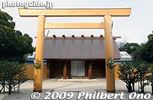
Atsuta Jingu Shrine's Hongu main shrine. For 1,000 yen, they let you in here to pray. The architecture and layout are almost the same as the Ise Grand Shrines in Mie Pref. Rebuilt in 1955. I wonder if the sacred sword is in there.
|
|
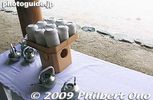
They also give you a small dish and sake served by a shrine maiden as you exit.
|
|

This is what we received for 1,000 yen. Some sweets as well. It also included a tea session. (See below.)
|
|

Shrine amulets were selling like crazy.
|
|

Shrines are in the business of selling good fortune and hope.
|
|

Votive tablets and other trinkets.
|
|
|
|

Description of various amulets in English.
|
|
|
|
|

Omikuji fortune paper.
|
|

Built in 1686 by Shogun Tsunayoshi, this is Nishi-gakusho, one of the few shrine buildings remaining from before the Meiji Period. Dances and other ceremonies are held here. 西楽所
|
|

Remnant of the Nobunaga-bei, a roofed mud wall donated to the shrine in 1560 by Oda Nobunaga in gratitude for his victory at the Battle of Okehazama.
|
|

Follow the sign to exit or to see other shrine buildings.
|
|

Homotsukan Treasure Hall houses and exhibits the shrine's valuable artifacts, including Important Cultural Properties and a National Treasure (a dagger). Many people donated stuff to the shrine, especially swords. 宝物館
|
|

Behind and attached to the Homotsukan Treasure Hall is the Bunkaden Culture Hall where they held a tea session. People form a long line as they wait to enter the Bunkaden. The tea was included in the 1,000 yen I paid to see the inner shrine.
|
|

This is the Bunkaden Culture Hall which is behind and attached to the Treasure Hall. This is where they held the tea session.
|
|

Inside the Bunkaden Culture Hall for tea.
|
|

The stage was appropriate for New Year's.
|
|

There was no ceremony. We just sat and were served tea and sweet.
|
|

A sweet confection to eat with the matcha tea.
|
|

The shrine maidens came around to serve the tea and sweet.
|
|

My bowl of matcha green tea. After we consumed the tea, we just left. The shrines also has many other buildings, but it was too crowded for me to see them all this day. I was too tired walk around more.
|
|
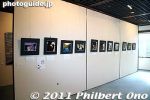
Motoyasu "Musashi" Matsutani showed scenic photos of Kyoto. These photos were also displayed the week before at a martial arts event in in Los Angeles, CA.
|
|
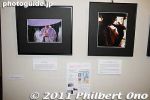
"I LOVE KYOTO" is the title of his photos.
|
|
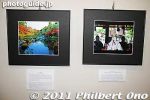
Photos of Taizo-in temple, festivals, and people.
|
|
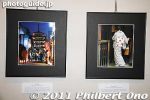
The photo of the back of a kimono woman was his favorite.
|
|
|
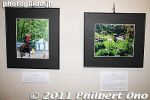
Yabusame
|
|
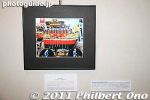
Gion Matsuri
|
|
|
|
|
|
|
|
|